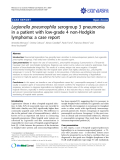
JOURNAL OF 108 - CLINICAL MEDICINE AND PHARMACY Vol. 19 - Dec./2024 DOI: https://doi.org/10.52389/ydls.v19ita.2528
135
Studying on single nucleotide polymorphisms of A20 gene
in non-Hodgkin lymphoma patients
Nguyen Trong Ha
1
*, Do Thi Trang
2
,
Nguyen Hoang Giang2 and Nguyen Ba Vuong1
1Military Hospital 103
2
Vietnam Academy of Science and Technology
Summary
Objective: To identify single nucleotide polymorphisms (SNPs) in exon 7 of A20 gene in non-Hodgkin
lymphoma (NHL) patients and evaluate the association between these SNPs and some prognostic
indicators in NHL patients. Subject and method: 83 patients were diagnosed with NHL and 83 healthy
controls. Sanger sequencing technique was used to analyze SNPs in exon 7 of A20. Result: Seven SNPs
were identified in the patient sample including A20: c.1308 A>C (p.K337Q), c.1341 C>T (p.L348F), c.1356
T>C (p.Y353H), rs2114496684 C>T, rs1776324713 A>T, c.1378 G>C (p.S360T) and rs2114496220 T>A. In
which, two genotypes CT and GC of SNP rs2114496684C>T and c.1378G>C respectively had higher
frequencies in the NHL group compared to the control group with a statistically significant (p<0.05).
Four SNPs: c.1308A>C (p.K337Q), c.1341C>T (p. L348F), c.1356T>C (p.Y353H) and rs2114496684C>T
(p.Q357*) were predicted to be associated with a high risk of NHL using Mutation Taster, CADD and
Polyphen_2 bioinformatics software. There was no statistically significant difference in the genotype
distribution of these SNPs with some prognostic indicators such as stage, progression, LDH and beta2-
microglobulin index in NHL patients. Conclusion: Seven SNPs were identified in exon 7 of A20 in the NHL
patient group, of which two SNPs with heterozygous genotypes appeared with a higher frequency in the
patient group compared to the control group with statistical significance, and four SNPs were predicted
to be associated with hight risk of NHL. There was no statistically significant association between the
genotype distribution of these SNPs and some prognostic indicators in NHL patients.
Keywords: Non-Hodgkin lymphoma, SNPs in exon 7 of A20 gene.
I. BACKGROUND
Non-Hodgkin lymphoma (NHL) is a neoplasm of
the lymphoid tissues originating from B cell
precursors, mature B cells, T cell precursors and
mature T cells. NHL comprises various subtypes,
each with different epidemiologies, etiologies,
immunophenotypic, genetic, clinical features, and
response to therapy. It can be divided into two
groups, 'indolent' and 'aggressive', based on the
disease's prognosis1. According to GLOBOCAN 2020,
Received: 09 October 2024, Accepted: 21 November 2024
*Corresponding author: bshaa7103@gmail.com -
Military Hospital 103
NHL ranks 13th both incidence and mortality rates in
Vietnam among all cancers2. There are many
methods for treating NHL including: Chemotherapy,
radiotherapy, targeted therapy and stem cell
transplantation... However, there are also cases that
respond poorly or do not respond to these
treatments. Therefore, understanding the molecular
mechanism of NHL plays important role in assessing
the prognosis of the disease as well as targeting
treatment in intracellular signaling pathways to
improve clinical outcomes and overcome resistance.
A20 is a deubiquitinase (DUB) gene that inhibits
activation of the NF-κB pathway, thereby
functioning as a tumor suppressor gene3. Mutations
that inactivate A20 lead to activation of the NF-κB










